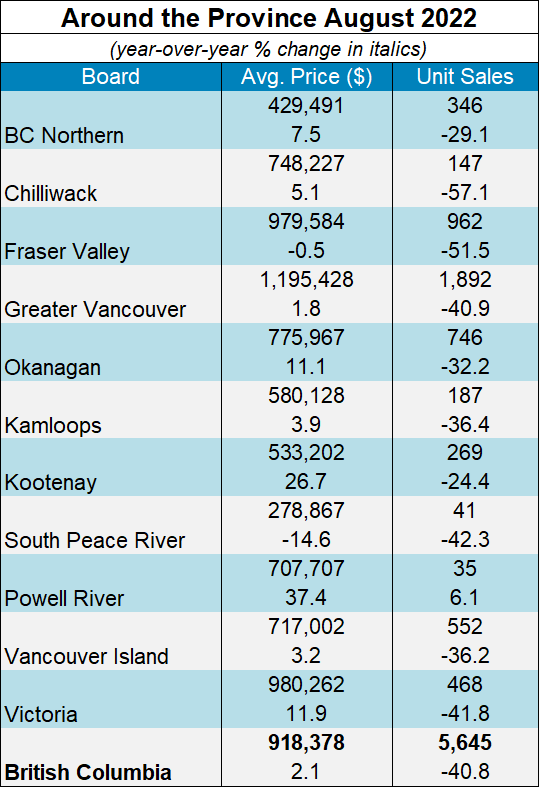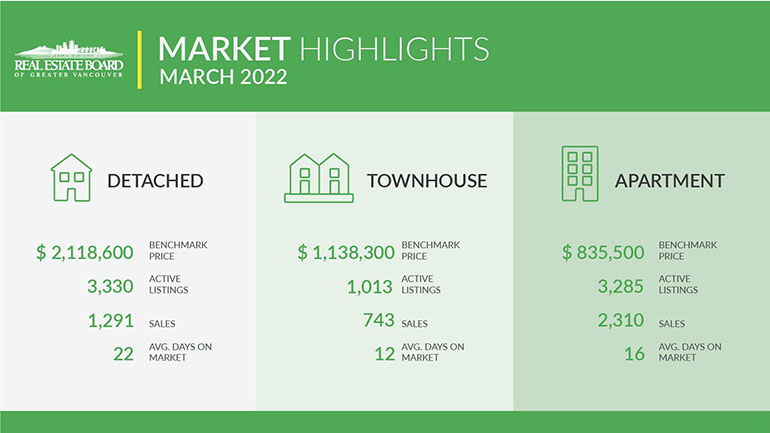FOR DATA BY AREA AND HOUSING TYPE SEE OUR STATS AT THE LINK BELOW:
https://www.dropbox.com/sh/z7dtb497t3yjqyu/AACk18Caw4sVCKZURBQilLZja?dl=0
There were 2,241 homes sold in Greater Vancouver in February this year compared with 2,461 sales in a record February last year and 4,254 homes sold in February 2016. This was 14 per cent below the 20 year average for February. Detached houses have seen a significant drop in sales with there being 622 sold in February 2018, 749 in February 2017 and 1,784 in February 2016. This was most pronounced in Vancouver’s West Side with there being 53 sales in February 2018, 93 sales in February 2017 and 226 sales in February 2016. In Richmond it was a similar story with 52 Detached Houses sold in February 2018, 92 sold in February 2017 and 204 in February 2016. It seems that the detached market lost all the speculation from it far before the provincial government stepped in. In February 2016, detached homes sales made up 42 per cent of all sales, in February 2017 they were only 30 per cent of all sales while this year that decline continued to 27 per cent. While the percentage of attached homes remained consistent between the three years, apartments made up 42 per cent of sales in February 2016 and 52 per cent of sales in February 2017 and 53 per cent this year.
There were 4,363 new listings in February in Greater Vancouver, up 16 percent from February last year and down from 27 per cent from February 2016. The amount of new listings in February 2018 were 9 per cent below the 20 year average for February. While detached homes are increasing in numbers, townhouse and apartment properties still remain in short supply with apartments seeing more instances of multiple offers than townhouses. Detached houses are entering buyer’s market conditions, certainly in the higher price points. With the implementation of the new taxes, the above $3 Million market will likely go deeper into a buyer’s market. With the lower end of the market in the attached side becoming more competitive and prices will continue to climb. Affordability certainly won’t be achieved by these government changes. And the Speculation Tax may decrease the rental supply even more as landlords decide to sell instead of paying the tax, even B.C Residents who could get a tax credit but would still have to pay the tax up front. We’ll await the final details of the tax in the coming months.
“Rising interest rates and stricter mortgage requirements have reduced home buyers’ purchasing power, particularly for those at the entry level or our market,” Jill Oudil, Real Estate Board of Greater Vancouver president said. “Even still, the supply of apartment and townhome properties for sale today is unable to meet demand. On the other hand, our detached home market is beginning to enter buyer’s market territory.”
East of the Fraser River, the Fraser Valley Real Estate Board processed 1,385 sales of all property types on its Multiple Listing Service® in February, a decrease of 0.8 per cent compared to 1,396 sales in February of last year, and 14.5 per cent increase compared to the 1,210 sales in January 2018. Of the 1,385 sales processed last month 336 were townhouses and 379 were apartments, together representing 52 per cent of all transactions in February.
Here’s a summary of the numbers:
Greater Vancouver: Total Units Sold in February 2018 was 2,241 – up from 1,846 (21%) in January 2018, down from 2,461 (9%) in February 2017, down from 4,254 (47%) in February 2016; Active Listings are at 8,421 compared to 8,200 at this time last year; New Listings in February 2018 were up 16% compared to February 2017 and down 27% compared to February 2016; Month’s Supply of Total Residential Listings is steady at 4 Month’s Supply (Balanced Market with Attached Acting Like a Seller’s Market) and a Sales to Listings Ratio of 51% compared to 65% in February 2017.
Vancouver Westside Residential: Total Units Sold in February 2018 was 429 – up from 1,846 (37%) in January 2018, down from 505 (15%) in February 2017, down from 852 (50%) in February 2016; Active Listings are at 1,553 compared to 1,376 at this time last year; New Listings in February 2018 were up 29% compared to February 2017 and down 26% compared to February 2016; Month’s Supply of Total Residential Listings is steady at 4 Month’s Supply (Balanced Market with Attached Acting Like a Seller’s Market) and a Sales to Listings Ratio of 48% compared to 73% in February 2017.
Vancouver Eastside Residential: Total Units Sold in February 2018 was 244 – up from 137 (78%) in January 2018, up from 229 (7%) in February 2017, down from 342 (29%) in February 2016; Active Listings are at 981 compared to 966 at this time last year; New Listings in February 2018 were up 17% compared to February 2017 and down 8% compared to February 2016; Month’s Supply of Total Residential Listings is down to 4 Month’s Supply (Balanced Market with Attached Acting Like a Seller’s Market) and a Sales to Listings Ratio of 51% compared to 56% in February 2017.
North Vancouver Residential Total Units Sold in February 2018 was 166 – up from 132 (26%) in January 2018, down from 216 (23%) in February 2017, down from 346 (52%) in February 2016; Active Listings are at 494 compared to 414 at this time last year; New Listings in February 2018 were up 9% compared to February 2017 and down 34% compared to February 2016; Month’s Supply of Total Residential Listings is steady at 3 Month’s Supply (Balanced Market with Attached Acting Like a Seller’s Market) and a Sales to Listings Ratio of 52% compared to 73% in February 2017.
West Vancouver Houses: Total Units Sold in February 2018 was 42 – down from 43 (2%) in January 2018, down from 57 (26%) in February 2017, down from 169 (75%) in February 2016; Active Listings are at 570 compared to 448 at this time last year; New Listings in February 2018 were up 36% compared to February 2017 and down 25% compared to February 2016; Month’s Supply of Total Residential Listings is steady up to 14 Month’s Supply (Buyer’s Market) and a Sales to Listings Ratio of 20% compared to 38% in February 2017.
Richmond Residential: Total Units Sold in February 2018 was 262 – down from 275 (5%) in January 2018, down from 338 (23%) in February 2017, down from 533 (51%) in February 2016; Active Listings are at 1,290 compared to 1,182 at this time last year; New Listings in February 2018 were up 28% compared to February 2017 and down 15% compared to February 2016; Month’s Supply of Total Residential Listings is steady up to 5 Month’s Supply (Balanced Market with Attached Acting Like a Seller’s Market) and a Sales to Listings Ratio of 41% compared to 67% in February 2017.
Burnaby East: Total Units Sold in February 2018 was 34 – up from 29 (17%) in January 2018, up from 17 (200%) in February 2017, down from 43 (21%) in February 2016; Active Listings are at 121 compared to 92 at this time last year; New Listings in February 2018 were up 40% compared to February 2017 and up 3% compared to February 2016; Month’s Supply of Total Residential Listings is steady at 4 Month’s Supply (Balanced Market with Attached Acting Like a Seller’s Market) and a Sales to Listings Ratio of 51% compared to 35% in February 2017.
Burnaby North: Total Units Sold in February 2018 was 89 – up from 73 (22%) in January 2018, down from 113 (21%) in February 2017, down from 195 (55%) in February 2016; Active Listings are at 297 compared to 332 at this time last year; New Listings in February 2018 were down 18% compared to February 2017 and down 41% compared to February 2016; Month’s Supply of Total Residential Listings is down to 3 Month’s Supply (Balanced Market with Attached Acting Like a Seller’s Market) and a Sales to Listings Ratio of 51% compared to 54% in February 2017.
Burnaby South: Total Units Sold in February 2018 was 135 – up from 102 (32%) in January 2018, up from 95 (42%) in February 2017, down from 227 (40%) in February 2016; Active Listings are at 353 compared to 384 at this time last year; New Listings in February 2018 were up 3% compared to February 2017 and down 38% compared to February 2016; Month’s Supply of Total Residential Listings is down to 3 Month’s Supply (Balanced Market with Attached Acting Like a Seller’s Market) and a Sales to Listings Ratio of 75% compared to 54% in February 2017.
New Westminster: Total Units Sold in February 2018 was 103 – up from 96 (7%) in January 2018, down from 108 (5%) in February 2017, down from 162 (36%) in February 2016; Active Listings are at 210 compared to 230 at this time last year; New Listings in February 2018 were up 6% compared to February 2017 and down 34% compared to February 2016; Month’s Supply of Total Residential Listings is steady at 2 Month’s Supply (Balanced Market with Attached Acting Like a Seller’s Market) and a Sales to Listings Ratio of 67% compared to 74% in February 2017.
Coquitlam: Total Units Sold in February 2018 was 178 – up from 156 (14%) in January 2018, down from 194 (8%) in February 2017, down from 372 (52%) in February 2016; Active Listings are at 511 compared to 455 at this time last year; New Listings in February 2018 were up 13% compared to February 2017 and down 36% compared to February 2016; Month’s Supply of Total Residential Listings is steady at 3 Month’s Supply (Balanced Market with Attached Acting Like a Seller’s Market) and a Sales to Listings Ratio of 60% compared to 73% in February 2017.
Port Moody: Total Units Sold in February 2018 was 42 – down from 46 (9%) in January 2018, down from 49 (14%) in February 2017, down from 87 (52%) in February 2016; Active Listings are at 131 compared to 123 at this time last year; New Listings in February 2018 were up 7% compared to February 2017 and down 39% compared to February 2016; Month’s Supply of Total Residential Listings is up to 3 Month’s Supply (Balanced Market with Attached Acting Like a Seller’s Market) and a Sales to Listings Ratio of 47% compared to 59% in February 2017.
Port Coquitlam: Total Units Sold in February 2018 was 84 – up from 58 (45%) in January 2018, up from 80 (5%) in February 2017, down from 190 (55%) in February 2016; Active Listings are at 168 compared to 185 at this time last year; New Listings in February 2018 were down 1% compared to February 2017 and down 44% compared to February 2016; Month’s Supply of Total Residential Listings is steady down to 2 Month’s Supply (Balanced Market with Attached Acting Like a Seller’s Market) and a Sales to Listings Ratio of 65% compared to 61% in February 2017.
Ladner: Total Units Sold in February 2018 was 19 – flat to 19 in January 2018, down from 47 (60%) in February 2017, down from 27 (30%) in February 2016; Active Listings are at 115 compared to 150 at this time last year; New Listings in February 2018 were down 15% compared to February 2017 and down 26% compared to February 2016; Month’s Supply of Total Residential Listings is up to 6 Month’s Supply (Balanced Market with Attached Acting Like a Seller’s Market) and a Sales to Listings Ratio of 42% compared to 89% in February 2017.
Tsawwassen: Total Units Sold in February 2018 was 29 – up from 16 (81%) in January 2018, up from 26 (11%) in February 2017, down from 60 (51%) in February 2016; Active Listings are at 173 compared to 192 at this time last year; New Listings in February 2018 were up 37% compared to February 2017 and down 55% compared to February 2016; Month’s Supply of Total Residential Listings is down to 6 Month’s Supply (Balanced Market) and a Sales to Listings Ratio of 43% compared to 53% in February 2017.
FOR DATA BY AREA AND HOUSING TYPE SEE OUR STATS AT THE LINK BELOW:
https://www.dropbox.com/sh/z7dtb497t3yjqyu/AACk18Caw4sVCKZURBQilLZja?dl=0














 1. Bringing Consistency to Insured Mortgage Rules
1. Bringing Consistency to Insured Mortgage Rules
